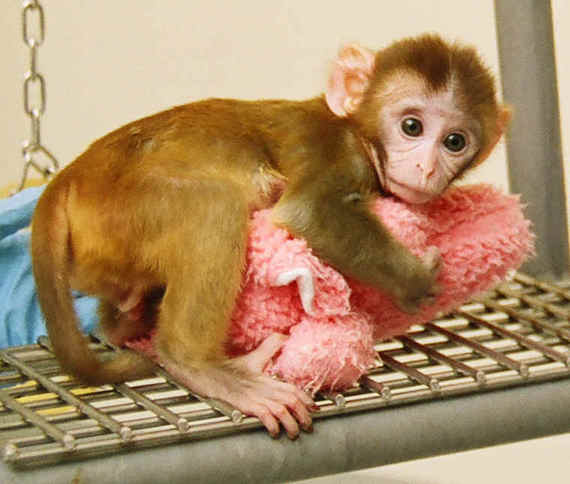Unlike the humble mouse, primates are afforded at least some protection under the Animal Welfare Act. Unfortunately, even the most prestigious universities have shown the inability to care for their primates without extreme and deadly consequences.
The USDA announced in December that they had fined Harvard Medical School $24,036 for killing four primates amongst a total of 11 animal welfare violations. One of the Harvard primates died due to being given too much anesthesia, another died of strangulation when a toys chain became wrapped around its neck, and two other primates had to be euthanized after they had become severely dehydrated due to neglect. It's a paltry amount considering it could have carried a heavier fine of $10,000 per violation. After an exhaustive USDA investigation prompted by Stop Animal Exploitation NOW! Harvard announced in April 2013 that it would largely shut down its primate research center by 2015. This was on the heels of the center's director resigning over the animal welfare violations scandal.
This was not the first time Harvard Medical School had come under scrutiny and been in violation of the Animal Welfare Act. In 2010, a primate had been left in its cage whilst the sanitization cycle in a mechanical cage washer was run. This incompetence was mitigated by the fact the primate was later found to have been dead already, the reason for which is unrecorded. The fact that a staff member failed to notice the dead animal prior to running the cage wash can only be described as grossly negligent.
In a period of just two days in December 2012, UC Davis managed to kill two young primates. A 6-month-old baby monkey died after a part of a stuffed animal used for "enrichment" purposes became wrapped around its neck. Another 19-month-old monkey also died when it became trapped in the squeeze mechanism of its cage. Just a year previously, on December 17, 2011 approximately 50 rhesus monkeys escaped from UC Davis primate research center by apparently breaking the hinges on the gate to their enclosure. (Is there a "Planet of the Apes" sequel in here?) Thirty-six of the primates had to be darted with tranquilizers in order to recapture them.
A July 2012 USDA report revealed that an Emory University employee returned a rhesus macaque monkey to the incorrect compound, which resulted in its death. The report also revealed dead roaches "too numerous to count" were in light shields over monkey enclosures, excessive amounts of rat droppings on the floor of another building, and live roaches in the kitchen. On the university website it states, "This is both a privilege and a heavy responsibility, and Emory is deeply committed to the ethical and compassionate treatment of the animals in its care." Obviously, caring for the animals is too heavy a responsibility for Emory; they can't even keep the primate enclosures clean.
At the University of Louisiana Lafayette (ULL), the primates fared little better. The university was fined $38,571 for a litany of animal welfare violations. In a USDA report dated February 2013, it states that three young rhesus monkeys died when they became trapped in the chute of an outdoor breeding colony. In what can only be described as shocking, employees did not notice for "several days." Primate housing at the university apparently wasn't designed to protect animals properly. This also resulted in a chimpanzee, which was recovering from anesthesia, sustaining injuries to its arm and hand when it reached through the drainage opening and was attacked by other chimps. Luckily, for most of the NIH chimpanzees they will no longer have to suffer from such gross negligence. It was announced in June 2013 that the NIH planned to retire all but 50 of its 360 chimps.
In a further USDA report on ULL dated August 2013, it was revealed that a mother monkey had her arm fractured between the squeeze mechanism and a closed "enrichment" door. Staff had been trying to take the body temperature of her infant. In the same report, it stated that another female rhesus monkey died after trapping her hand between a space in the bottom of a metal conduit and another portion of her enclosure.
In what must have been a bid for freedom, the same USDA report stated that five capuchin monkeys tried to launch a mass escape from ULL, and who could blame them? They removed the latch clip from their enclosure door and escaped. Apparently, monkeys are clever enough to work a latch clip, perhaps animal lab techs - not so much.
The University of Louisiana has a track record of violations of the Animal Welfare Act. In 2010 they were fined $18,000 for:
•Sedating nonhuman primates with darts in social groups, which caused extreme stressful behavior in the group.
•The IACUC failed to have a proper description of the proposed use of animals.
•Records of sedation methods and procedures for primates in a "pole and collar/chairing studies" were incomplete.
•Three mother primates were left without adequate medical care under sedation whilst their infants tried to vigorously arouse them.
•African green monkeys were left unprotected in inclement weather resulting in one monkey getting frostbite on its tail, which then had to be amputated.
•Failure to provide environmental enhancement for nonhuman primates.
Oregon Health and Sciences University was fined $11,679 for violations of the Animal Welfare Act. In a report dated May 8, 2012 nine macaque monkeys also made their bid for freedom and escaped. Lab technicians had forgotten to lock the door of the outdoor enclosure. Like Lafayette, the primate enclosures weren't constructed to contain the animals securely and prevent the accidental opening of the enclosure. (I'm starting to think about Betsy, the capuchin monkey of "Outbreak" here!)
Oregon was so reprimanded because their Institutional Animal Care and Use Committee (IACUC) "..failed to review and approve changes regarding the care and use of animals in ongoing experiments. An employee administered two compounds that had not been approved to two macaques resulting in the death of the animals."
Three more macaques died during 2009 at Oregon Health and Sciences University due to untrained personnel overseeing animal care. One died when staff didn't sedate and monitor the animal properly, and two died of dehydration. The facility was cited for not providing adequate water to EVERY single primate in the facility.
Last but not least, at Texas Biomedical Research Inst. two juvenile macaques died within three months of each other. They had both become entangled in the door cable between the indoor and outdoor enclosure. Again, staff negligence was cited in the Jan 24, 2013 report which stated, "Personnel had to be trained how to maintain doors and appropriate animal moving practices."
It is not the job of the animal care staff in vivisection laboratories to ensure they are properly trained; it is the responsibility of the institutes. In what appears to be an alarming trend, prestigious institutes seem to be engaging in cutting corners where training staff and handling animals is concerned. When I hear the response over and over again from these laboratories that animal welfare is at the top of their priority list, I have to disagree. Not only is the animals welfare apparently inconsequential, and only of concern when they are caught red-handed, it begs the question how trustworthy are you? If you cannot even provide water for the animals in your care, how can we trust the results of the experiments?
Ex-NIH Director, Dr. Elias Zerhouni recently stated, "We have moved away from studying human disease in humans. We all drank the Kool-Aid on that one, me included. With the ability to knock in or knock out any gene in a mouse--which "can't sue us," researchers have over-relied on animal data. The problem is that it hasn't worked, and it's time we stopped dancing around the problem...We need to refocus and adapt new methodologies for use in humans to understand disease biology in humans."
I couldn't say it better myself. For the sake of the animals and for the sake of everyone desperately seeking a cure for their diseases, let's stop drinking the Kool-Aid and believing in the PR spin of the vivisection laboratories. Let 2014 ring in a true year of change for animals in laboratories everywhere.
For more information please visit www.saenonline.org

